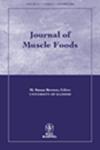CHANGES IN QUALITY DURING STORAGE OF VACUUM-PACKED SEA BASS (DICENTRARCHUS LABRAX, Linnaeus, 1758) COOKED BY DIFFERENT METHODS
Abstract
ABSTRACT
This work evaluates the chemical, microbiological and sensorial characteristics of vacuum-packed sea bass processed by different cooking methods under different time/temperature conditions and storage at 2C. The heat treatments applied in core were: 5 min, at 180C for frying, 30 mi, at 230C for baking, and 16 min at 2450 MHz for microwave cooking. Chemical, microbiological and sensory quality changes were investigated periodically. In all groups; the total viable and psycrophilic bacteria counts increased throughout the storage period of vacuum-packed sea bass. Total viable counts of fried, baked and microwave-cooked sea bass reached 6.06, 7.00, 7.24 log cfu/g, respectively, after 15 days. On day 15, the total volatile base nitrogen (TVB-N) value of microwave-cooked sea bass exceeded the allowable limit of 38.72 mg/100 g, whereas the TVB-N value of fried and baked sea bass reached 22.46 and 29.85 mg/100 g, respectively. Therefore, it can be concluded that frying at 180C for 5 min in core is the most effective cooking method to ensure the safety and extend the shelf life of fried sea bass, preserving its microbiological guality.
PRACTICAL APPLICATION
This study establishes the chemical, microbiological and sensory quality of vacuum-packed sea bass and emphasizes the relevance of the quality changes of the different cooked sea bass. Heat treatments and storage temperatures are very important to ensure the safety of the fish product.

 求助内容:
求助内容: 应助结果提醒方式:
应助结果提醒方式:


